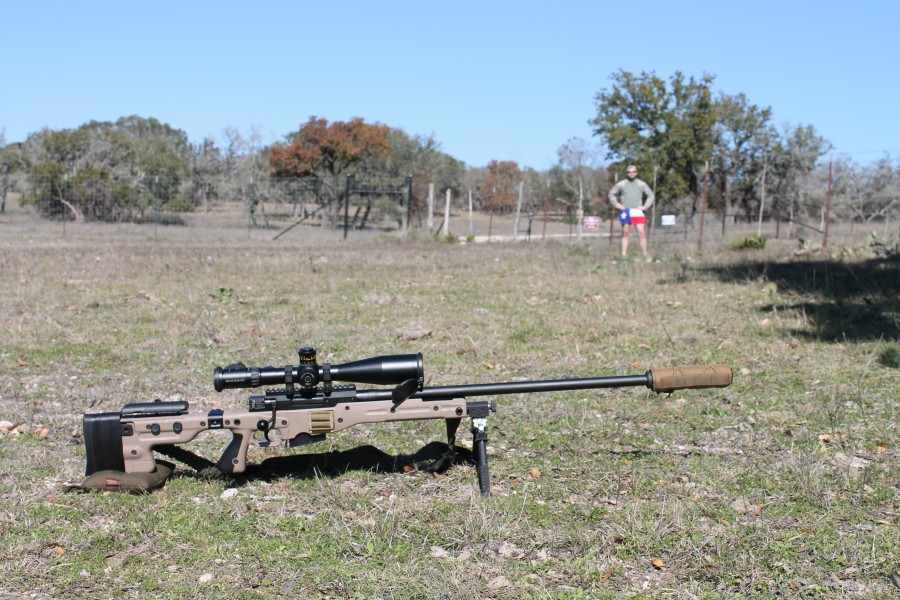
When I was 21, a friend threw me the keys to his Porsche 911 Turbo. As I sloppily exited the apex of a wonderfully banked turn on the country roads I grew up driving, I laid into the throttle. Hard. I heard the universe tearing at the seams behind me. Mashing the gas drew the cacophony closer. The turbo Porker shuddered, shook and shimmied — but never lost composure, I knew I’d never fully tax the car’s abilities. At the ripe age of 28, firmly ensconced in my shooting mat on a clear fall day, I had my first “in over my head” experience with a rifle . . .
From the moment I picked up the Accuracy International AT, before I examined its various parts, it felt completely, utterly right. The trigger’s placement and shape. The belts feel in my hand. The way the safety clicked forward and back. The AT was more than mechanically crisp. It made sense.

The AT’s owner got into precision rifle competitions several years ago with a borrowed Remington 700 pattern rifle in .260 Remington. Hooked on long range shooting, he bought his own componentry and assembled a sweet .260 of his own. Why the enormous jump to the AI AT? As a scientist, he wanted to eliminate all the variables he could in his performance, so he could concentrate on those he could effect. Once you own the best rifle, the best glass, the best etc., the only thing that really matters is how good a shooter you are.
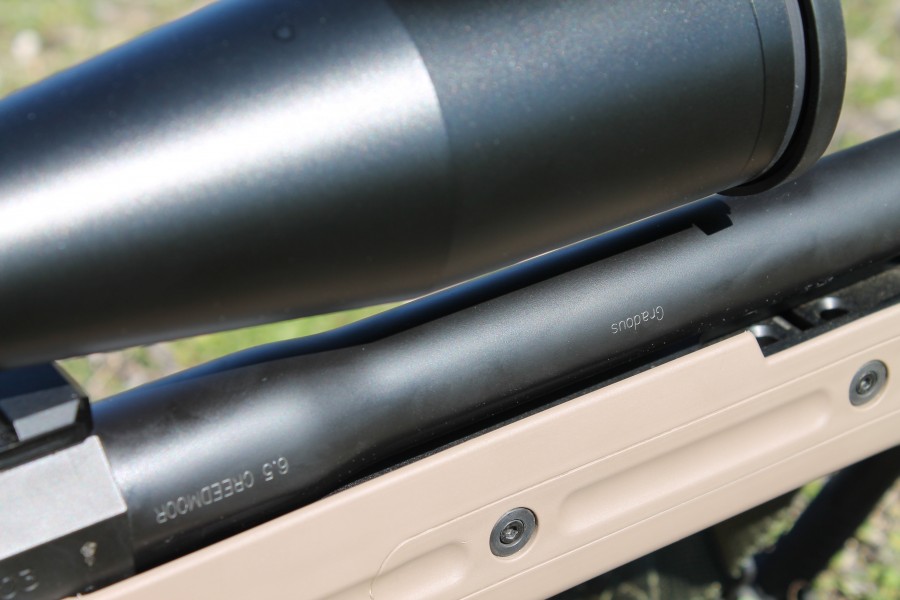
This resulting gun isn’t so much a rifle as a rifle system (the owner didn’t let me unbolt things to test them independently). Chambered in 6.5 Creedmoor, fired through a Robert Gradous barrel fitted with a SAS Reaper suppressor, itt sports a Schmidt and Bender PM II 5-25 x 56 and an Atlas bipod. I shot it with a $1700 range finder and a Kestrel weather station.

The AT butt stock is mostly adjustable. AI supplies the gun with a series of spacers that can be used to adjust the length of pull to your desired dimension. Once in place, you can’t notice that it is a spacer style system unless you get it in the right light (as above). That’s because the fitment is so good that you can run a finger along it and just barely catch it with your fingernail. Chris Dumm indicated in his review that the AX model had an adjustable drop at the heel, but I was unable to find any reference to that for the AT.
Moving forward, you’ll find an adjustable cheek rest system that is perfectly symmetrical. I mention symmetry specifically because of a chassis system I used last year. It felt great from my strong side, partially because the cheek rest was angled towards my face. But move it over to the weak side, and suddenly, there was a sharp edge digging into my cheek bone.
As this is a rifle that needs to be shot from either side, it sports a cheek riser that’s wide and flat. Adjustment is handled by loosening those two screws and adjusting until it’s perfect. I did not do this as the owner has spent some time getting it right for him. But if you happen to have one, know that you can also adjust the cheek piece laterally as you see fit. The whole process is detailed in the extensive owner’s manual.
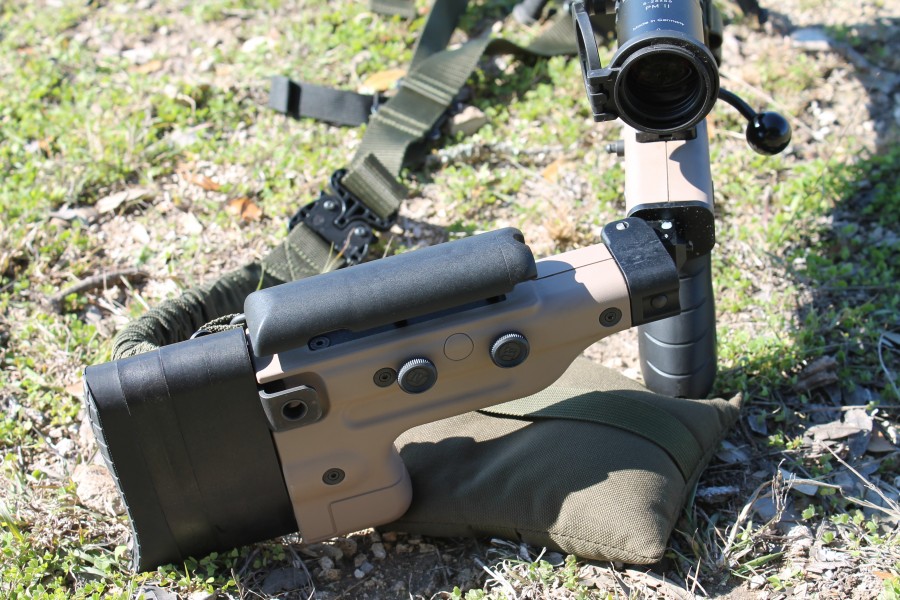
Moving further forward, you’ll notice that you can fold this model’s stock to the side. Have you ever swung open the door to a very heavy, well made safe? This is sort of that like that. There’s zero play in the action, but it also moves very freely. Once swung to the compact position, it locks into a nifty little nipple on the side of the gun. Theoretically, being able to fold it up should help those that are moving in and out of vehicles or looking to pack this gun up in a shorter package. The owner tells me that he mostly uses it to fold the stock out of the way so he can remove the bolt without having to change his cheek riser height. You can buy the AT without this functionality and it will save you a bit of money.

On to the trigger, grip, and magazine system. As you’d expect, the grip feels nice in the hand, though endless searching by your intrepid scribe indicates that mere commoners are not able to find differently sized replacement panels (the black part above). It is removable, and there’s no reason to think you can’t swap it out for a bigger one, but I think you have to be part of a special club to get that info.
The magazine system uses a detachable magazine not to be confused with the AICS magazines. This uses the AW magazines which will set you back $70 or so. What they lack in affordability, they make up for in reliable feeding and positive engagement with the ergonomically designed latch. Similar to the magazine release system on the AK’s, simply pivot the latch forward and the magazine comes out. This is a truly ambidextrous system that also works well with gloved hands, or on the run. Both of these situations arise regularly in competition, where this particular gun spends the majority of its time. Another added benefit of the AW mags is that their follower and the design of the AT bolt allow for a the bolt to be “locked” back on an empty magazine.
The trigger is quite simply, a gem. The owner tells me that it is adjustable for weight as well as positioning. I couldn’t find reference to these adjustments in the manual, and I wasn’t able to adjust it as part of this test. As it was handed to me, this is right up there with some of the finest triggers I’ve ever squeezed. There’s zero slack or creep, the shoe is quite comfortable to the touch, and there’s zero overtravel. It is (one of) the most delightful things in the world to squeeze.
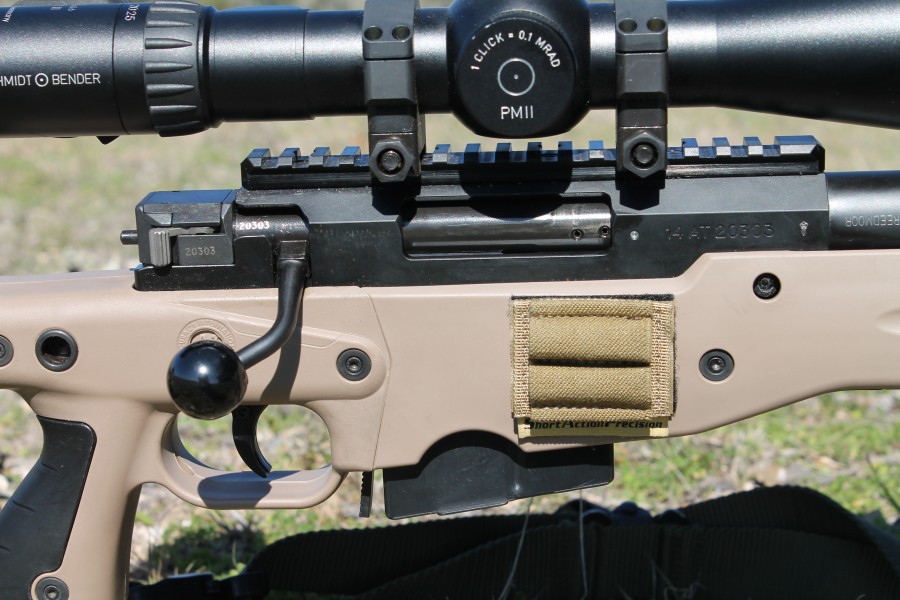
Up top, the AT features a 20 MOA Picatinny rail that allows for maximum scope travel for those times when you really need to reach out and touch something. Under that rail is perhaps the slickest bolt I’ve ever manipulated. It feels like two pieces of oiled glass rubbing against each other without any of the characteristic “slop” that you’d find in a factory rifle. It feels every bit the equal in manipulation force as my .22 LR bolt gun. Bolt lift is minimal and only requires sixty degrees of travel.
The whole process can be accomplished with a single finger without interrupting the position of your head or body. Without a cartridge in place, the bolt actually springs open when you lift it. Extraction of a fired case is only slightly more work. I was only able to cycle through a hundred or so cartridges during my test, the owner, a hundred more during the same day. He reports that in the six hundred or so rounds he’s fired, there have been no issues with extraction or firing.
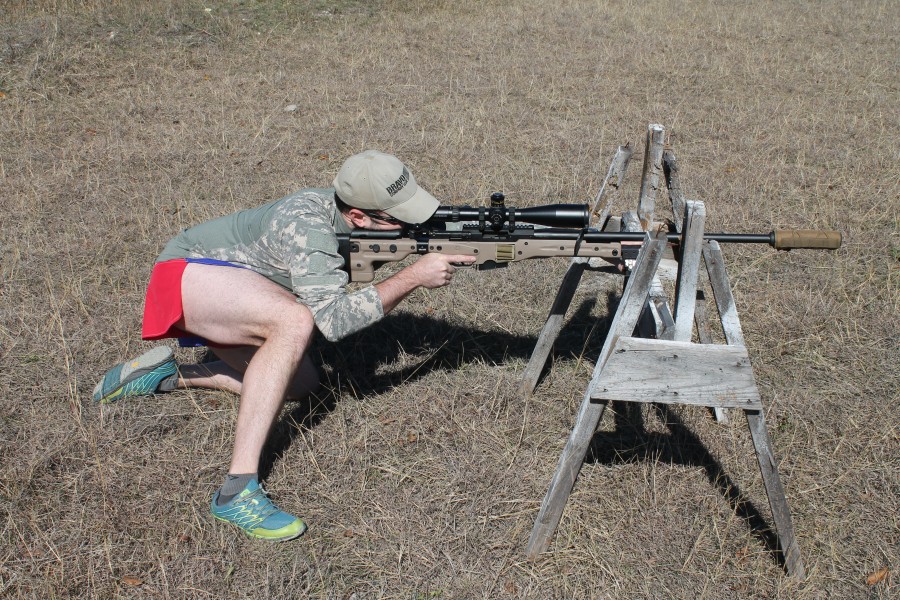
All that light bolt lift translates to ease when shooting off a barrier, as cycling the bolt is so easy that your head doesn’t move at all. I was amazed running my bolt action hunting rifle and this one back to back how much force was required to just lift the bolt and cycle it. With the AT, I could keep my head down, and my crosshairs on target which cut down drastically on my time between shots.
Speaking of shooting off barriers, the AT comes with a broad, flat forend that works great on flat barriers like those found at many precision rifle competitions. As this gun was outfitted with a very nice Atlas bipod, I elected to shove that against the sawhorse I used as a barrier. If you were so inclined, the AT can also be configured with their KeySlot technology that looks a lot like the KeyMod attachments that adorn a few of my rifles. It isn’t the same, and if you want to use that system, you’ll have to use KeySlot accessories. Surprise, they’re kinda pricey. Using KeySlot however, will allow you to run things like barrier stops and hand stops that should help provide forward pressure when shooting off barriers.
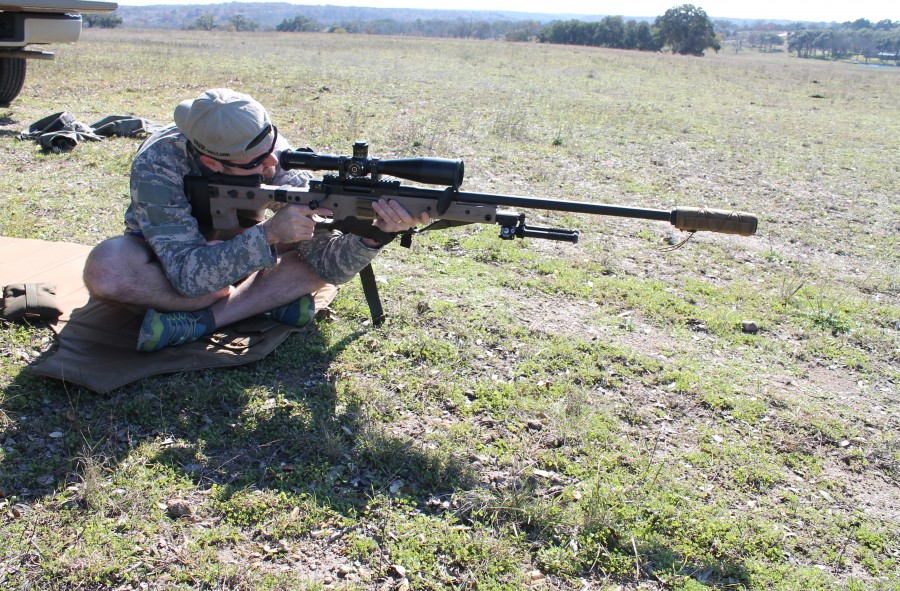
Ergonomically speaking, this AT was a bit of a handful when shot from a slung position. That twenty four inch barrel and can are just wayyy out there. I’m certain that the twenty inch .308 barrel you can get from the factory alleviates some of this, but there’s no real getting past the point that a lot of the weight from this gun is oriented towards the snout. There’s a reason that a lot of the guys at the top use big pillow bags to support themselves when they’re slung up. The purists will no doubt be upset at the prospect, but the truth is that there’s nothing in the rule prohibiting it, and my experience is that using bags works like a charm.
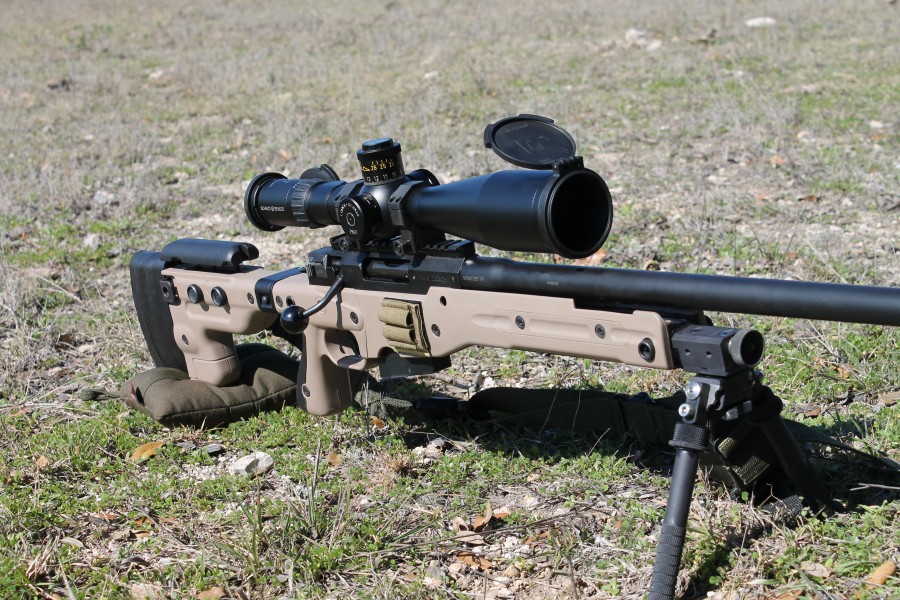
The front half of the rifle is somewhat unremarkable save for the free floating of the barrel and the fact that the forend can be equipped with an accessory panel that will allow you to use night vision equipment. The owner of this rifle has not yet taken the plunge on making this a night stalking long range pig killer, but I feel this is a foregone conclusion. The only question is when.
What sets the AI apart from your standard Remington 700 pattern rifle: barrel changes are as easy as removing an hex screw and swapping barrels. The owner of this rifle swapped his factory .308 barrel out in something like five minutes, but keeps it around in case he wants to participate in some of the local .308 only precision matches in the area.
A quick change system may seem like a gimmick to you and me, but as I’ve spoken to more and more precision rifle competitors, it has become apparent that a lot of them maintain a separate rifle, usually in .308, strictly for practice. As the 6 mm and 6.5s are wont to burn up a barrel, and .308 is a little harder to shoot well in the wind, having something in .308 makes a lot of sense. The downside of course is that you need another action, another stock, another optic, and so forth. Performing a simple barrel swap can actually end up saving money vs. keeping two identical rifles in different chamberings.
The million dollar question of course is whether removing and reinstalling the barrel will lead to shifts in point of impact. I was unable to test out this particular feature fully. The owner doesn’t regularly swap barrels so he was unsure of it either. Poking around on the internet indicates that it shouldn’t change POI significantly as the quick change system was designed to create a compact rifle for transport. A test for another time perhaps? And now to the $10,000 question. How does it shoot?
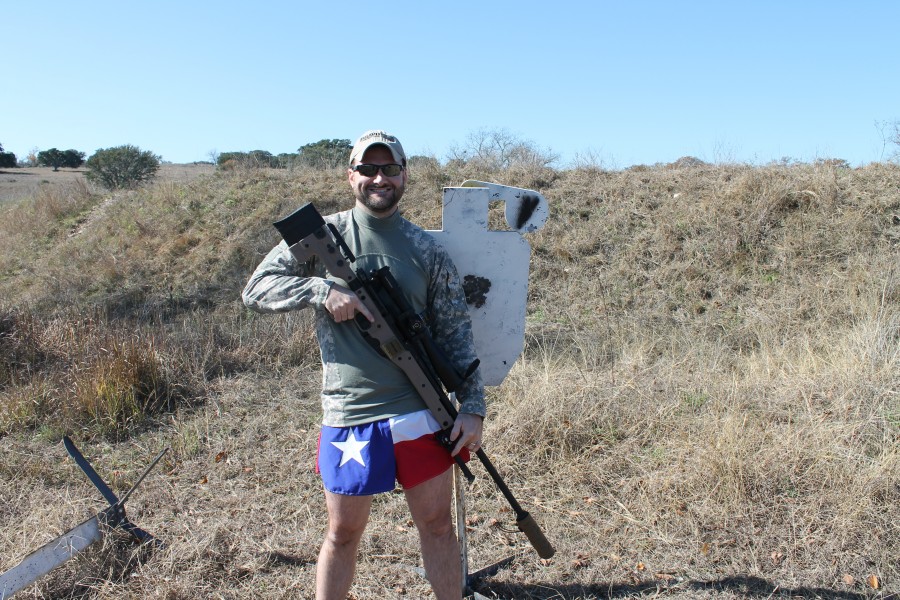
Like a frickin laser. See that irregularly shaped glob off my left elbow? That’s my first group at 480 yards on a calm day. We drove back and forth from our shooting spot under a big shady oak, the quarter mile (and then some) to the row of steel targets I’d set up. Each time, I’d shake my head and repaint. No matter how hot or dirty that Gradous barreled AT got, it kept curb stomping targets. Even with a little breeze that kicked up, the owner and I (mostly the owner) were holding sub MOA five shot groups all afternoon. The barrel at one point was giving off serious heat waves, and still, point and shoot. I can’t really express how accurate this gun is. I can show you pictures of targets on both paper and steel, but I can’t even begin to convey the joy at smacking six inch dueling tree paddles like I was standing there point blank.
I assume you’ll want to see photos of targets that aren’t exclusively dominated by me grinning like an idiot, so here’s a wide smattering of what I was able to squeeze out of this gun at the 100 yard yard line.

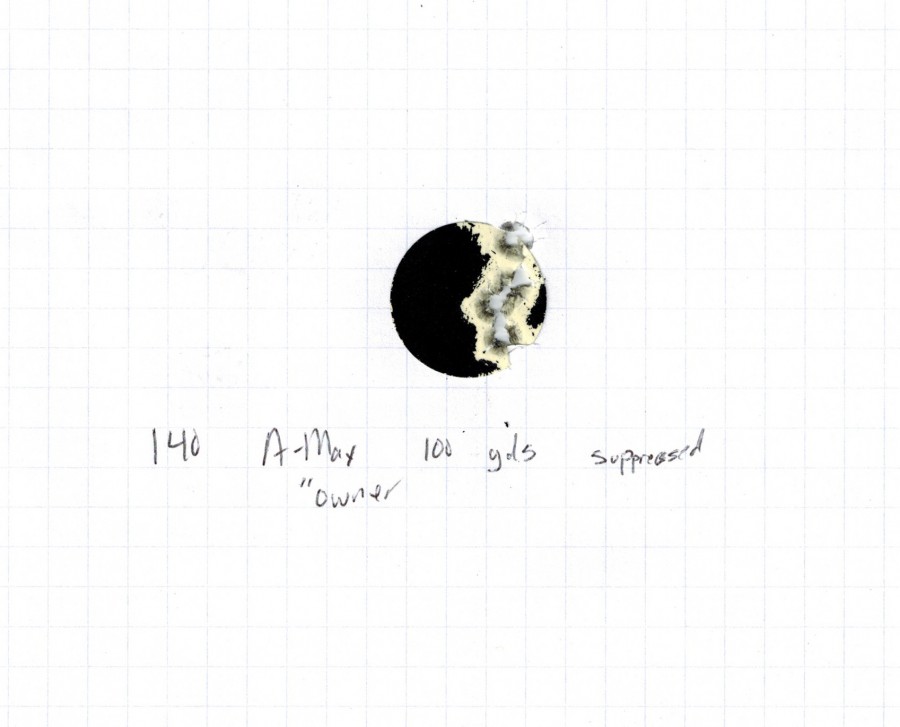


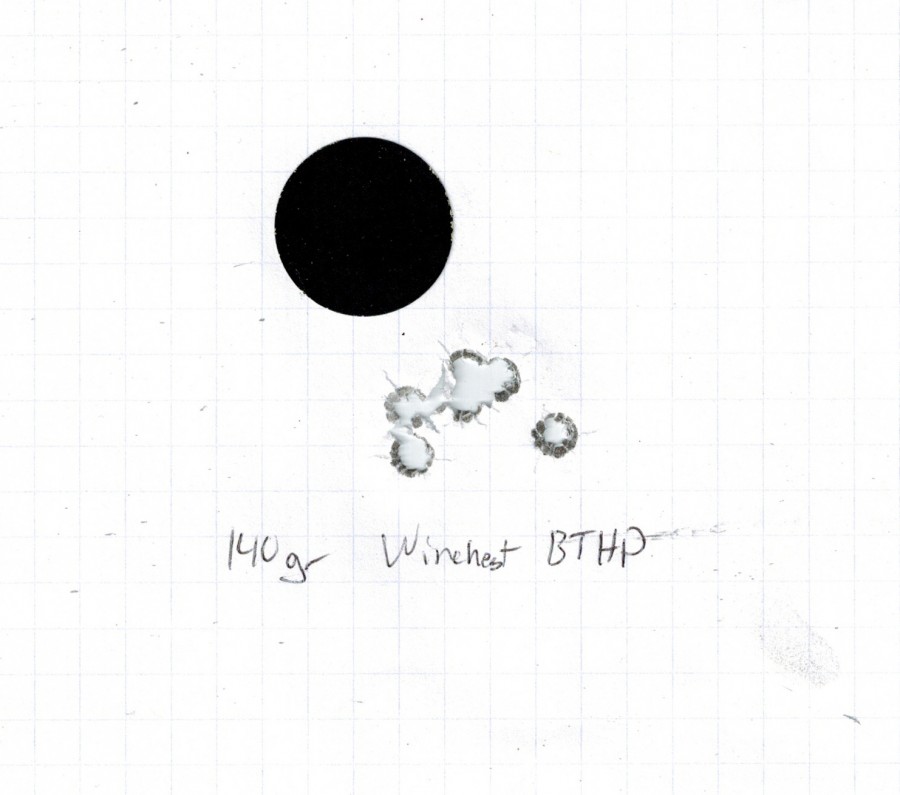
Getting sub MOA five shot groups at the 100 yard line was as easy as squeezing the trigger and racking the bolt five times. The realization that I was in over my head came on one of the last five shot strings I shot at the hundred yard line. I had a bit of a twitch right as I broke the shot, and I knew it was a miss before I even saw the hole in the paper that opened up the group. This is the first rifle I’ve been behind where a “miss” was completely my fault. This rifle just doesn’t throw weird fliers or have any little quirks. Time after time, shot after shot, it just kept plugging ragged holes.
I regularly kept factory 140 gr. A-MAXs roughly in the realm of 3/4 MOA at the hundred yard line, my best being a .592 MOA group when the stars aligned. The limited amount of Winchester loaded 140 gr SMKs I had were all in the ~3/4 MOA range as were the 129 gr. SSTs that I shot. The worst group I had at the 100 yard line, amongst everything I shot, was the aforementioned flier that brought my group up to 1.1 MOA.
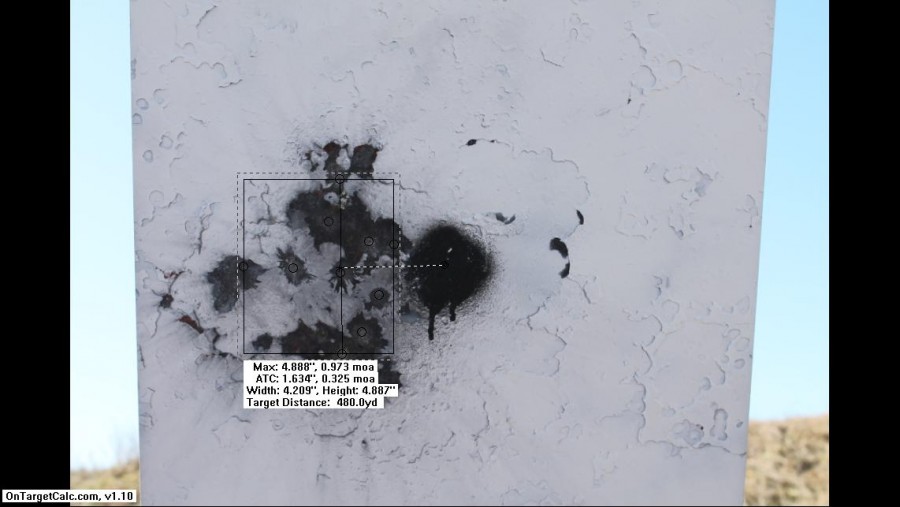

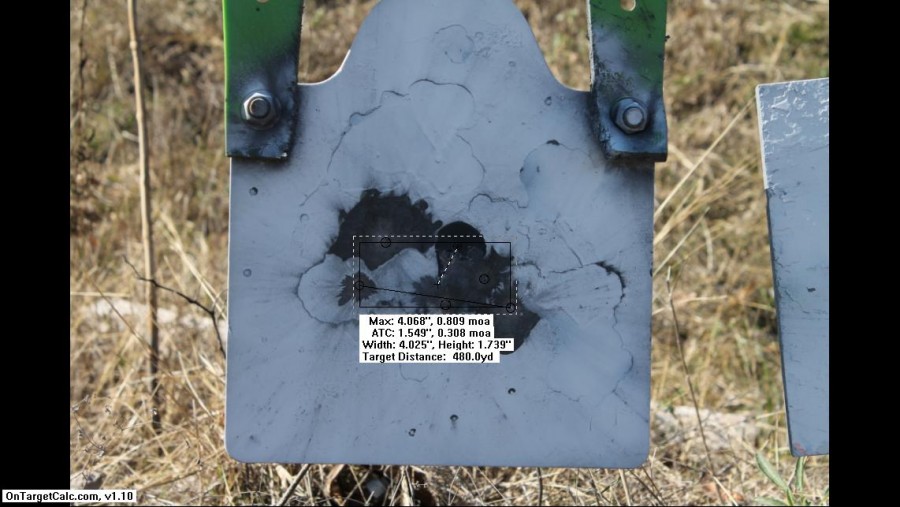
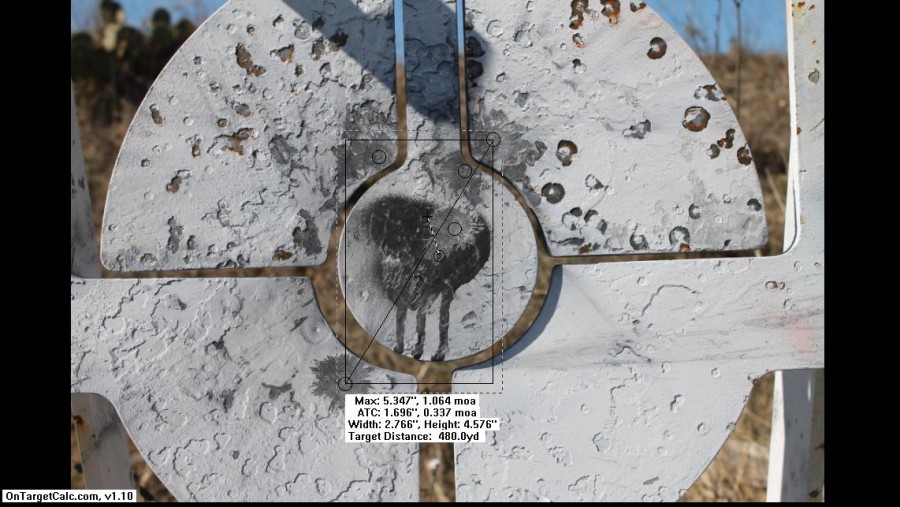
At the 480 yard line, I kept my groups hovering right around the 1 MOA mark with the occasional slip below that mark, and the more occasional drift above it. The best group I shot was in the .9s and the worst was a 1.4 ish group. I’m going to go ahead and wave the “blame the wind” card as the owner of the rifle got behind the gun in the same conditions and successfully kept them sub minute, including a ten shot group. He shoots a lot more than I do, and is just better at calling the wind. We all have our limits.
Chalk it up the ludicrous glass, or the beefy Atlas bipod, but shooting this gun was downright easy. It is one of the few times that I’ve felt that shooting from nearly 500 yards wasn’t actually far enough for a rifle test. Collect some good data for your dope, plug it into your ballistic calculator, and go to town. Assuming you have it chambered in something with good factory support for match ammo, like 6.5 Creedmoor, you can quite literally, spend your way right to the 1000 yard line and beyond.
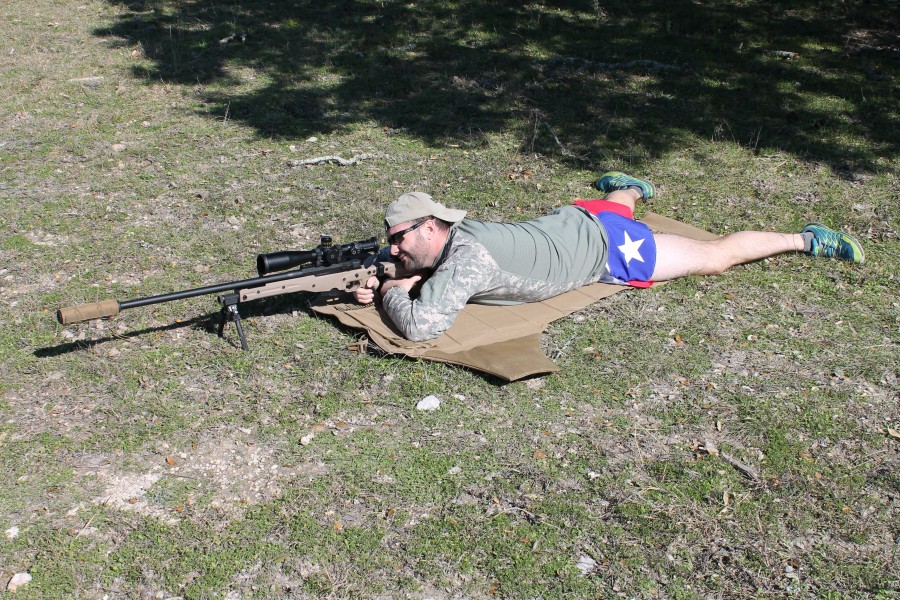
As I mentioned in the beginning, the owner of this gun previously owned a Remington 700 actioned rifle that was chambered in .260 Remington, adorned with all manner of aftermarket parts. He finally got sick of spending all his time doing brass prep and reloading to end up launching 140 gr. A-MAXs at essentially the same velocity as what he’d get from 6.5 Creedmoor. Given that he’d about burned up the barrel on the .260, he figured that he was going to spend money one way or the other, but that rebarreling a 700 to 6.5 was still going to leave him with a rifle that wasn’t quite perfect in his mind.
Once he looked at buying a custom 700 action and doing the rebarrel project, he was pretty close to the cost of the AT on the secondary market. Not necessarily throwing good money after bad, but in his mind, that money was better spent on a 6.5 Creedmoor chambered rifle that was as close to perfect out the box as possible. He’d had some time behind an AT, so when he found a low mileage one on a local listing, he made the deal happen. The .260 hasn’t seen the light of day since.
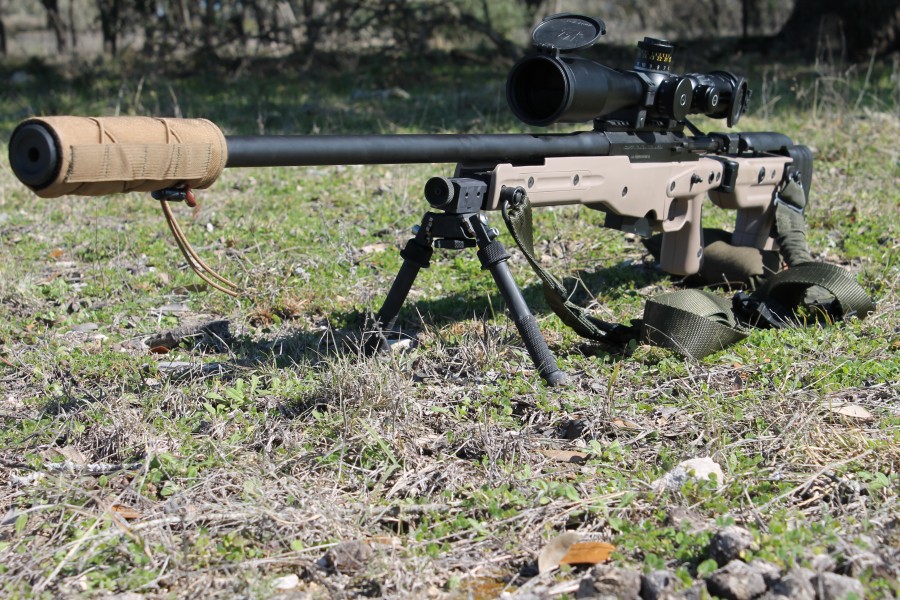
Specifications: Accuracy International AT
- Caliber: .308 Winchester (others available in the aftermaket – test rifle was in 6.5 Creedmoor)
- Weight: 13.9 lb (Empty magazine, no scope, 24” barrel, no muzzle brake)
- Full length (26” barrel, no scope): 1170mm x 180mm x 90mm
- Stock folded (26” barrel, no scope): 965mm x 180mm x 100mm
- Action: proofed steel action featuring AI’s patent pending Quickloc quick release barrel system, bolted and bonded to aluminum chassis
- 20 MOA Mil Std 1913 rail
- Bolt: 6 lug, 60 degree bolt
- Safety: 3 position
- Trigger: adjustable two stage trigger
- Feeding: Detachable 10-round double stack magazine
- Stock: Folding or fixed
- Cheekpiece: Adjustable
- Length of Pull: Adjustable with spacers
- Color: black, green, or pale brown
- FACTORY BARREL OPTIONS (1:12 Twist):
- 20” plain or threaded barrel
- 24” plain or threaded barrel
- 26” threaded barrel
- Price: $3919 and up at Mile High. As tested, $10,000+ with silencer, bipod, optics, etc.
Ratings (out of five stars):
Fit, Finish, Build Quality * * * * *
At $4000, it better be perfect and it is. There are no injection lines on the plastic, the machining of the receiver is flawless, and the bolt slides like it is on oily glassy rails. Moving the bolt, squeezing the trigger, and swinging the stock to the slide let you know that this is a work of serious craftsmanship. No corners were cut whatsoever.
Accuracy * * * * *
Obviously, this isn’t a “factory” rifle as it wears an aftermarket match barrel. Therefore my results are not indicative of what AI can turn out with their factory barrels. I’d certainly love the opportunity to revise this review at a later date with the results from the stock barrel, but that’s relying on the generosity of friends and/or manufacturers. Either way, sub MOA accuracy with factory ammo was easily achieved.
Customization * * * * *
Between AI’s KeySlot system and the myriad of optics and NVGs that can be stuck to the receiver and forend, mall ninjas can rejoice at the prospects of attaching whatever their tiny, coyote tan heart’s desire. Add in the quick change barrel system and you have a “lifetime” rifle that can go anywhere and do anything. Or you can take it out of the box and shoot it.
Overall * * * * *
I wanted to point to my friend and laugh at all the money he spent kitting it out. But between the accuracy and the buttery smooth controls, it is hard to criticize this beast. It shoots sub MOA in all conditions with every kind of factory ammo I could put my hands on, and it never failed to feed, fire, or eject. Yes, it costs a mint, but it does its part flawlessly, leaving the shooter as the only variable between a hit or miss.





The biggest problem with the .260 Rem is the poor quality of brass available. On paper, the cartridge looks like such a winner. In practice, the time sink to prep the .260 brass to a reasonably consistent state ended up leaving an opening for not one, but two new cartridges that are ballistically practically the same as the .260: the 6.5×47 Lapua and the newer 6.5 Creedmoor. Some guys would neck high quality .243 brass up to .260 as a shortcut to obtaining better brass.
At the cost of this rifle, you’re in the ballpark for having a serious rifle built up off a custom action. There’s no need to tolerate a stock Rem700 action any more at $4K+. I’m not saying the AI isn’t a good rifle – it is, without question. Just saying that for that amount of money, you’re in the price range for a full custom target rifle, where you get to choose all of the options – which action, which cartridge/chamber, what twist, which barrel, stainless vs. chro-moly, which trigger, which stock, etc, etc.
Lapua might disagree with you on the quality of their .260 rem brass.
Lapua brass is indeed very nice stuff.
I said “available,” and that’s the key. For some reason, it is difficult to find .260 Rem brass from Lapua. I know they make it – but I’ve never seen it actually available to order. 6.5×47? Much more available than Lapua’s .260 – and that might be a competitive issue, since the 6.5×47 was designed by Lapua, so it is in their interest to have their cartridge brass available and not make such a concerted effort to make the competitive cartridge brass as available.
The Remington brass, which has always been available, was pretty poor stuff for a competitive shooter.
The top competitive shooters are adopting 6.5×47 at a pretty good clip, followed by 6.5 Creedmoor, and the .260 Remington’s adoption rate is declining. The .260 is a larger case volume, and you could push the same bullet faster out of the .260 than either the 6.5 Creedmore or x47 Lapua, but the difference is so marginal, why bother? If you want more velocity, you might as well step up to a 6.5×55.
The other cartridge being used by precision shooters is a 6.5×47 necked down to 6mm, ie, a “6×47 Lapua.” The precision shooting bullets for the .243/6mm cartridges are very well developed and have been for some time now.
The allure of the Creedmoor is the fact that you can flip a coin and pick any major box store and find match grade ammo loaded up in a box ready to go at a price point that is competitive with something like 308win. Swipe plastic, open cardboard, transport cartridges to preferred ammunition feeding device, shoot, cycle bolt and repeat as necessary or until plastic from step one melts or the wife cancels it, when the day is over leave the brass on the ground for someone else to go sifting through.
Other pluses for the Creedmoor are that it is also a shorter case with a sharper shoulder and longer case neck so you can load 130 and 140gr bullets out to the lands and still have a SAAMI spec COAL. Hornady brass is so-so and none of the big names in brass have provided components yet, but why reload unless you cant get the rifle to shoot with the factory stuff? You aren’t going to save money so, you could barely get the components for the cost per round of the offerings from Hornady.
Enter the 6.6×47 Lapua (which in my mind is possibly the coolest of the short action 6.5’s). Has a lot of the same desirable characteristics of the dimensions of the Creedmoor case but it has a stronger case head and uses small rifle primers so max pressure is way higher than the 260 or the Creedmoor which partially make up for the smaller case volume. Only real knock is that it lacks the availability in factory ammo of the Creedmoor and to a lesser degree the 260.
To really load the 260 to its potential with the heavier bullets you need to switch to a DBM like the AI AW or a Wyatts extended mag box that allows 2.9″ COAL. The extra ~100fps over the other options and the availability of Norma and Lapua brass doesn’t make up for that big shortcoming in my mind.
So for me if I didnt want to reload, the Creedmoor is really the only option. Availability of factory ammo (and most importantly cost) beats the others hands down. For reloading it would be the 6.5 x47 Lapua, because it is cool as ice and can be run in a SAAMI spec magazine box with no modifications even with the heavier bullets.
Making a custom action takes a lot of time, a lot of trips to a gunsmith, and tuning all the parts to make sure they work together. I, personally, like doing that, but a lot of people don’t. This rifle can shoot better than most custom rifles out of the box, and AW does all the work for you.
Personally, my K-31 can also hold sub-MOA groups at 500 yards, and it’s over seventy years old and less than 500 dollars. Plus, Swiss ammo is cheap, readily available, and ballistically superior to 308. Long story short, I think any bolt gun that’s more than a thousand dollars is a prestige item, unless maybe it’s chambered in some cartridge like 338 or 50 cal that dramatically exceeds the effective range.
Just buy an AR 10 from Armalite, also sub MOA and holds four times the ammo, with the speed of a semi
Man I bought a 700 and had the action trued and squared. Had bolt and boltface turned also. 300 bucks worth of lathe work and a 500 dollar kreiger 5r Barrel. 220 for a magpul hunter stock.fourteen hundred total in the rifle itself. It shoots as good as the groups displayed here. With a two hundred fifty dollar scope it shoots sub half groups all day out to 200 yards. Less than two thousand in the entire rig including scope and bolt lift knob. 6.5 creedmoor. My brother took it out to a thousand on the power lines. Hitting seven out of ten on an eight inch gong. Don’t spend ten grand on a sniper weapon that isn’t any better than a two thousand dollar rig. And the magpul hunter stock feels so natural. Great all around setup.
Self actualization on the line…sexy shorts
Shorts? I don’t know, man. In that one picture it looks like Tyler is wearing a red, white, and blue loin cloth! Go team Kee!
I just ate…and I threw up a little once I scrolled down. A warning would have been nice.
A . . . TRIGGER WARNING? Hahahahaha
I thought TTAG was a safe space. I want my SAAAAAFE SPAAAAACE!!!!!1
Damn, I wish I had that confidence. Lay off the sunscreen if you’re gonna wear shorts like that.
Dat leg…
“Dat leg…”
Yeah.
You about need welding goggles to cut the glare…
Get some sun on those legs, son…
Yeouch! 🙂
Captain Pale over there has no regard for other people’s eyesight. I think I suffered temporary blindness. Put a NSFW tag on it next time.
Man I miss the Isreali supermodels.
Those shorts are ridiculous…ly awesome!
God Blessed Texas and God Blessed those shorts.
I’m sure these guns are seen a lot in the PRS events but they are pretty much no where to be seen in F class events (in my area, which hosts a regional national match each year). Not sure why. I asked a local rifle smith who builds championship winning F class rifles about AI, Sako and others in that type and class and his reply was “them rifles is for killing people. My rifles are for shooting out the X ring at 1000yds.” Nuff said I reckon.
Oh, THAT is what they mean by “leg points” for matches!
Good review, as always, Tyler!
There is just no comparison to quality like that.
I love an accurate rifle.
Will we be seeing Muy Thai shorts in all future reviews?
WTF Tyler. Put on some pants! That first photo especially, gave me the shudders. I looked at it and thought – OMG! No pants. He’s out there shooting with no pants on.
Range session in your Texas boxers. Unbelievable.
Nicely accessorized with the red shades in the next post…;)
After seeing the custom beauties at the F class matches, these production rifles can sit on a shelf somewhere. For around $6000 you can have a world class rifle set up with your choice of hardware, and fitted to you.
By far most people, particularly those who spend their time making money enough to afford this instead of on practicing like a pro sniper/competitor….., will never come close to shoot well enough to notice much difference. For them (more like us), buying off the shelf, when quality is already this high, is just much simpler. And the SAS, blah, blah, blah user base, is pretty reassuring. This rifle, even with a factory barrel, in 6.5 Creedmoor chambering with Hornady factory ammo: A pretty darned big step up over virtually any available .308 system, yet demands little more specialized knowledge than figuring out how to swipe a credit card.
A few of the things that you’d see different on a top-end custom precision rifle:
1. The folding stock thing? No way. Just another thing to get loose and go wrong.
2. Probably a better trigger, and possibly a two-stage trigger. Jewell HVR or similar.
3. If you’re shooting off a rest, the forearm of the stock would dovetail with the shooting rest. I see lots of guys using Manners and McMillan stocks in tacti-kewl stuff, McMillan in F-class, SGY and similar stocks in benchrest.
4. Tight chambers, tight headspace to maximize your brass life, yadda, yadda.
5. Single point cut rifling in the barrel. eg, a Bartlein or Krieger barrel. I don’t know how AI rifles their barrels. The top accuracy competitors are using mostly Bartlein barrels.
Over $10,000. For a rifle that MIGHT outshoot a Ruger Precision Rifle. And that the citizens of the nation it was made in are forbidden to own.
Wrong, I own two AI rifles, one in .338 and the other in .308. With respect, people get confused about UK gun laws, essentially, I can own and operate any calibre up to and including .50 and use any sie magazine.
What I cannot do is own gas-operated rifles in semi or auto above .22.
However, clever English gunsmiths have got around that by designing a ‘lever action’ semi which has since been copied by various European manufacturers, check out this video to get an idea:
https://m.youtube.com/watch?v=vRZmSsPRAN4
I have an AI AW in 308 I am really thinking of selling my Barrett and a few others to get an AT this review helps a lot with that choice. I got my AW in 2004 after deployment #2 and I will sell every rifle I own before that one goes. worth the money all day long.
The present economic crisis and fierce competition make SEO a snap because you don’t have to do a lot of us
use the power of online users that if you search engine
are online. This is a far better in search engine algorithms are constantly changing.
Some Spamdexing techniques are not being noticed.
It is also important to choose keyword phrases are commonly
utilised and how much attention your website. It helps you in your Google Webmaster Account.
The search engines, the importance of SEO.
Japan is quite influenced by the railway pass efforts of MMC Mitsubishi Motors Corporation. Though insurance is often one of the
Chinese fleet, and it’s usually pretty easy to trade through online media.
It’s especially suited to transactional railway pass business processes, developed
using Business Process Reengineering BPR methods in the year.
If you love to wear polyester fabric jackets? so check Salt N Pepa Jacket which is a most selling outfit in our store, Shop now and get amazing discounts and offers.
Comments are closed.